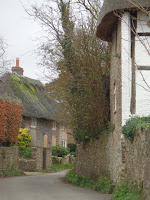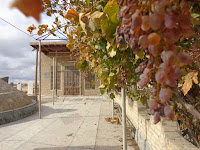Birthday parties for adults are so much more fun than those for children. You usually don't have to bring a present, there's often more yeast devoted to beer than cake, and you sometimes get to shoot stuff. Well, at least that's what I did recently at a friend's 40th birthday, in which the focus of the party was "medieval weapons training."
On a Saturday morning, I took the train to Amberley, a village in West Sussex, whose thatched-hut serenity didn't belie any of the afternoon's cutthroat activities (left). It was a blustery morning in the country, and unfortunately, as I walked among the village's narrow streets (right), some bit of greenery blew into my eye.
I repeatedly flushed out my eye, but it remained red and watery. And a mild pain made it uncomfortable to focus on Amberley Castle across the fields (left). Upon its hilltop perch, the winds were even stronger, and I was worried that between my bum eye and the fierce gusts, the weapons training on the castle grounds might be a bust (right).
Although the castle's turrets are intact, a walk through the gatehouse revealed that much of the original structure is now in ruins (left). But there are still walls enough to keep the resident peacocks contained. Nonetheless, polite signs remind guests staying in the castle hotel to close doors to keep the birds out of their rooms (right).
Luckily, the peacocks had already been penned up for the season, so there was no chance of a stray arrow felling a peafowl. With my dominant eye still acting wonky, I didn't think the meager burlap backdrop would compensate enough for my lack of aim (top left). To my surprise, I hit the target 90 percent of the time, but I was still not confident enough to compete in a shootout for 20 Scottish pounds (top right). For whatever reason, I seemed to have the most natural knack for throwing axes, even though the sweet spot was much smaller (bottom).
I used my eye strain as an excuse to escape the cold, where I relaxed beside a roaring fire in the women's restroom within the castle (top left). Indeed, the castle is the real deal: If the authentic suit of armor isn't enough to convince you (top right), consider that Henry VIII once came to the castle to seek counsel from Bishop Sherbourne about his divorce from Catherine of Aragon. As the sun went down, just after 5 p.m. this time of year, we headed into one of the castle's many dining rooms to revive ourselves with high tea (bottom).
Later that night, we ate dinner at The Bridge Inn, where a kindly bartender who overheard me talking about my ailing eye pulled out an emergency eye patch. Looking like a World War II casualty throughout the meal seemed a little ridiculous, but it was definitely restorative. By the time I woke up the next morning, I was able to truly enjoy the view out the window of my room at Woodybanks Cottage B&B (left). A whole herd of deer -- I stopped counting at 20 -- ate their morning repast on the South Downs as I enjoyed my full English breakfast (right).
Sight reinstated, I decided to join some of the archery/crossbow crew from the day before on a hike to nearby Arundel, also known as TimeOut Country Walks II No. 22 walk (top left). Our ramble took us through many muddy pastures where we were watched closely by roaming cows (top right). I, however, kept my now fully functional eye on the windswept landscape (bottom).
About two-thirds of the way through the walk, we stopped at The George in Burpham for Sunday roast dinner (left). We weren't the best-smelling group in the bunch, but luckily the proprietors of the community pub welcome diners with dirty boots. We took a quick swing by St. Mary the Virgin church before setting out on the last leg of the hike (right).
I figured the last 5K would be a breeze, but I didn't account for the fact that we would have to plod through the mucky banks of the River Arun. The sun was starting to fall as we finally saw Arundel Castle through the mist in the distance. From Arundel, we caught the train back to London, in time for me to make the weekly pub quiz at a local boozer. All in all, even with no goody bags as party favors, it was a good weekend.




































































